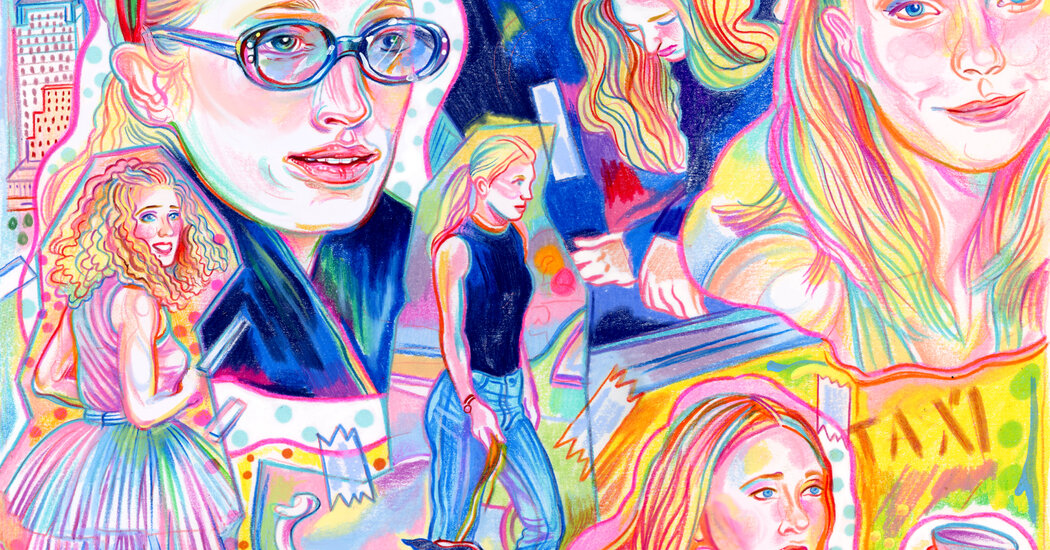On the morning of Dec. 31, 1999, I took the subway into Manhattan from my home in Brooklyn. At the corner of Seventh Avenue and 34th Street, I snapped a photo of the Millennium Clock with my 35-millimeter Kodak camera. Since 1998, a year after I first arrived in the city, it had been counting down the hours, minutes and seconds until the year 2000. I wanted a memento of that day. Then I high-tailed it off the island. If the world was going to shut down (or worse) at midnight, I intended to be closer to home.
When I returned to my apartment in the early hours of Jan. 1, 2000, having danced the night away at a sweaty bar in Williamsburg, I scrawled “We made it!” across a page in my journal in sparkly pink pen.
Everything is different, and nothing has changed.
Had I gone to sleep on New Year’s Eve in 1999 and waked today, Rip Van Winkle style, much of the world I left behind that night would still feel familiar. Fast-fashion hubs like Urban Outfitters are peddling baby tees and baby-doll dresses. Point-and-shoot cameras, like the one I toted into the city, flip phones and even smoking are making a comeback. Perhaps most notable, I’d still recognize a shocking number of the people currently wielding influence over our lives, not least because so many of them were prominent in New York City at the time.
A short, partial, list: In May, “And Just Like That,” the “Sex and the City” spinoff, premiered its third season, with Carrie still mooning over Aidan. Gwyneth Paltrow graced the April cover of Vanity Fair. Jennifer Lopez opened the American Music Awards. Brad Pitt and Tom Cruise are starring in two of this summer’s blockbusters. Sean Combs was just on trial. TikTok has granted Carolyn Bessette Kennedy a certain immortality, and Ryan Murphy’s upcoming “American Love Story” is about the tragic arc of her relationship with John F. Kennedy Jr. When images from the show’s wardrobe tests were released, a segment of the internet flew into a days-long outrage so intense that Mr. Murphy publicly mounted a defense.
It’s not just pop culture. New Yorkers still have Chuck Schumer trolling the Senate; he took office in 1999 and never left. And, of course, our president: It was in the 1990s that Donald Trump became an avatar for wealth and excess. It’s as though Generation X, of which I am solidly a member, is wreaking some strange revenge. The people we put in power and the culture we created currently have an outsize influence on the world.
Part of the allure of the 1990s is a longing for the days when we were a monoculture — a world before the fractured intake of smartphones, a time defined by a (retrospectively) comforting reality in which we experienced many of the same things at the same time. But I think there’s more to it.
“Whatever happened to fun?” beseeches Lexi Featherston, played by Kristen Johnston, in a 2004 episode of “Sex and the City,” before her stiletto slips and she plunges to her death. We were, just a handful of years into the millennium, already desperate for a return to an imagined carefree past. It’s tempting to think a certain (less dangerous) unencumbered spontaneity is the one thing we did leave back in the 1990s, an era without location tagging, when phones required quarters.
What New York, or the fantasy of it, offered in the late 1990s was an outsize version of what so many of us are craving now: the promise of real-life connection, mixed with the potential of wealth, beauty and love.
Keith McNally, the restaurateur responsible for the late-’90s New York powerhouses Balthazar and Pastis, is now big on Instagram and just published a best-selling memoir. So did Graydon Carter, who took over Vanity Fair in 1992 and now runs the popular Air Mail newsletter. Tina Brown, whom Graydon Carter replaced at Vanity Fair — and who threw one of the last truly great media parties when the short-lived Talk magazine began in 1999 — is currently a Substack star. Anna Wintour, who took the helm of Vogue in 1988 and just announced her exit as editor in chief, solidified her image in the 1990s, shaping how we all saw fashion.
Manhattan was a handy stage for all this revelry. During Rudy Giuliani’s time as New York mayor, from 1994 to 2001, the city emerged out of decades of rising crime and urban decline — the economic collapse of the 1970s, the crack epidemic of the 1980s — to what the former New York Observer editor Peter Kaplan once described in New York magazine as an “immovable feast.” That is: a great, self-sustaining party. From 1996 to 1999, overall crime rates plummeted. The Dow surged. Real estate prices spiked. The hedonism of 1970s sex culture, long dormant, began to revive with the arrival of highly effective antiretroviral therapy to fight AIDS in 1996.
When the cultural gaze and the newly empowered tabloid media turned its eye on New York, it found more Emerald City than Gotham. So much money. So many expense accounts. So many parties. Being shoved up against the uncertain millennium only added to the intensity of the celebration.
This rejuvenated city, with its cleaned-up Times Square, was not without brutally dark moments. Foreshadowing the racial reckoning of 2020, in 1997 members of Mr. Guiliani’s newly empowered police department brutally assaulted a Haitian immigrant named Abner Louima, starting a wave of protest and condemnation. Two years later, police officers fired 41 shots into a 23-year-old unarmed immigrant named Amadou Diallo, killing him. It wasn’t only the police brutality. In the fall of 1999, Mr. Giuliani notoriously tried (and failed) to evict the Brooklyn Museum of Art over his aversion to an exhibition that included Chris Ofili’s work “The Holy Virgin Mary” (1996), which depicts a Black Virgin Mary adorned with elephant dung.
We’ve recaptured the sense of impending doom that permeated that time. Of course, all the Y2K anxiety that gripped the city was misplaced. The real apocalyptic moment wouldn’t arrive for another 20 months, on Sept. 11, 2001. After that, we began a descent into daily life spent more in the palms of our hands, on ever smarter screens.
And now here we are, in another moment also rife with apocalyptic intensity, in a city trying to hold the line against the president it birthed through a shattering of democratic traditions and constitutional breaches.
Still, I can’t help but wonder what will put an end to this nostalgic moment.
We got a glimpse of what that might look like during New York’s Democratic mayoral primary on June 24, when the 33-year-old democratic socialist Zohran Mamdani crushed the former governor Andrew Cuomo (who first entered government in, you guessed it, the 1990s). Suddenly it seemed that youth culture might introduce a whole different kind of collective, and one actually suited to this moment. Perhaps we’re finally ready to face a new era with originality — and maybe even a little fun.
Glynnis MacNicol is the author of the memoir “I’m Mostly Here to Enjoy Myself” and the host of the podcast “Wilder: A Reckoning With Laura Ingalls Wilder.”
The Times is committed to publishing a diversity of letters to the editor. We’d like to hear what you think about this or any of our articles. Here are some tips. And here’s our email: [email protected].
Follow the New York Times Opinion section on Facebook, Instagram, TikTok, Bluesky, WhatsApp and Threads.
The post Why Are We Doomed to Keep Reliving the ’90s? appeared first on New York Times.




